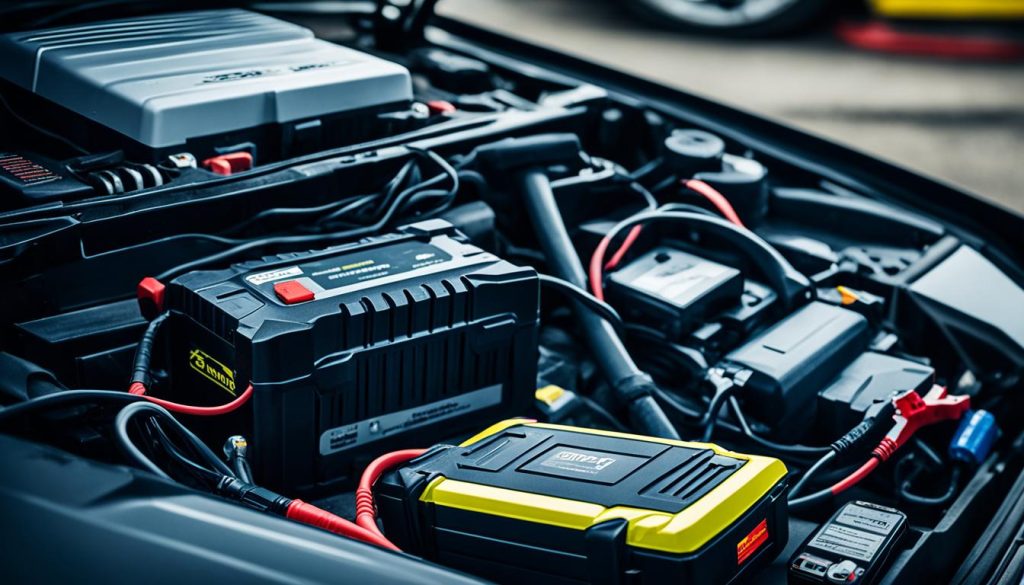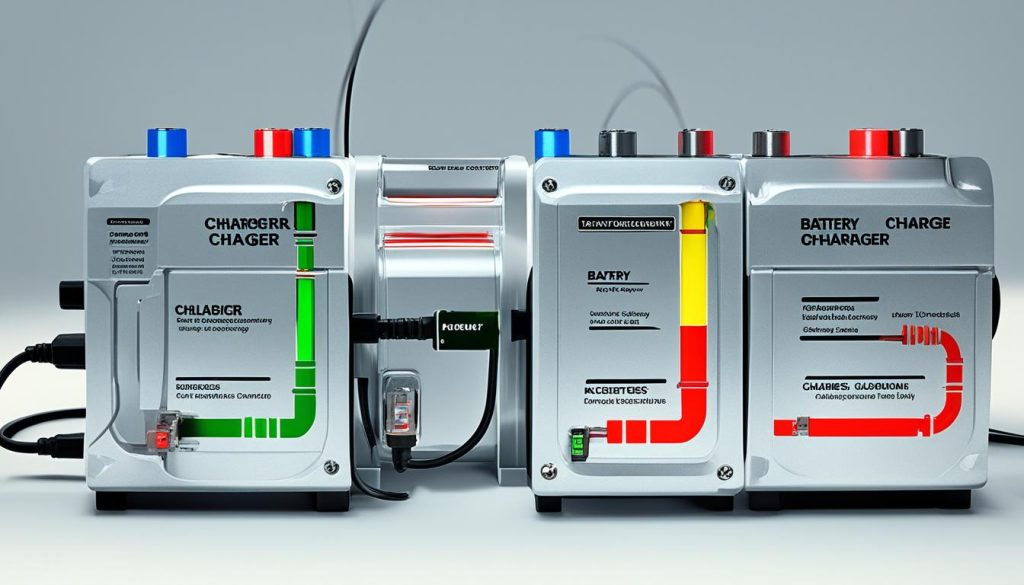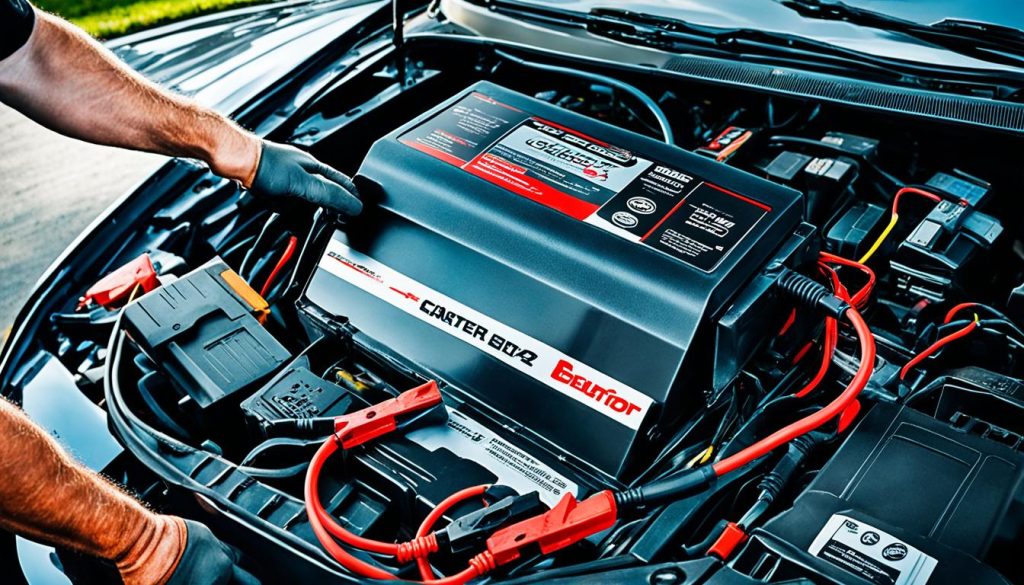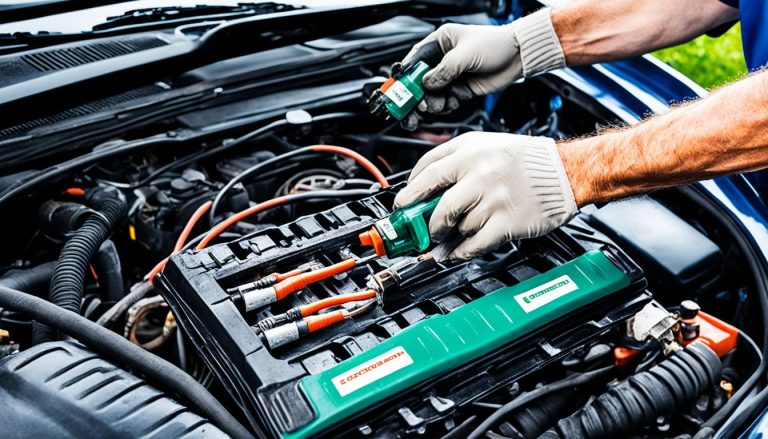Battery Charger vs Jump Starter: Best Choice?
batterychargers.site and its partners may earn a commission if you purchase a product through one of our links
As a vehicle owner, you know how crucial it is to keep your car running smoothly. Battery chargers and jump starters are two vital tools that help ensure you’re never left stranded due to a dead battery. But when it’s time to give your car’s battery a boost, you may wonder whether a battery charger or a jump starter is the better option for your needs. To guide you through this decision, let’s explore what makes the best battery charger tick versus the advantages of the best jump starter out there. Both have their unique roles in vehicle maintenance, but understanding the battery charger vs jump starter debate is crucial in making an informed decision.
Key Takeaways
- Battery chargers replenish your car’s battery over time and are ideal for maintenance.
- Jump starters offer immediate power to get your car running, without the need for a full charge.
- Understanding the differences is vital in selecting either a battery charger or jump starter.
- Portability and emergency usage favor the jump starter, while battery longevity prefers the charger.
- Some devices provide additional features making them versatile automotive tools.
Understanding the Essentials of Car Batteries
Maintaining a reliable car battery is more than just a convenience; it’s a fundamental aspect of ensuring your vehicle is powered up and ready to face any journey. A diligent approach to car battery maintenance can prevent unexpected stalls and costly repairs, keeping you and your vehicle on the move.
Importance of a Reliable Car Battery
Consider your car battery as the heart of your vehicle—vital for keeping the electrical system alive and kicking. A reliable car battery means the difference between a car that starts instantly every morning and one that leaves you stranded. Ensuring your battery is in top condition aligns with seamless performance and an uninterrupted driving experience.
Common Reasons for Car Battery Drain
Several factors contribute to car battery drain, a pervasive issue in vehicle ownership. Here are some common scenarios to watch out for:
- Extended periods of inactivity that leave your car battery without the necessary regular charging
- Frequent short trips which prevent the battery from fully recharging, leading to a gradual loss of power
- Severe weather conditions putting extra demand on your battery to support systems like defrosting and lighting
| Reason | Explanation | Impact on Battery |
|---|---|---|
| Lack of Use | Batteries naturally discharge and need regular recharging from use. | Power depletes without the chance to recharge |
| Short Drives | Insufficient time for battery charging during brief trips. | Never reaches full charge, life diminishes |
| Cold Weather | Increases electrical system’s demand on battery. | Heavy strain leads to quicker drain |
Armed with the knowledge of these common battery concerns, you’re better prepared to manage and prevent car battery drain, ensuring battery charging processes are effective, and your vehicle remains reliably powered up. Remember, proactive car battery maintenance is key to a long-lasting and dependable driving experience.
Demystifying the Battery Charger
The modern car battery charger is an essential tool for optimal battery maintenance. Its primary role is to ensure your car battery remains charged and ready for use, effectively extending the battery’s life. Let’s delve into both the advantages and potential limitations associated with its usage.

The Role of a Car Battery Charger in Battery Maintenance
Regular use of a car battery charger can be a game-changer for maintaining your vehicle’s battery health. It provides a sustained, gradual charge, which is perfect for keeping batteries at an optimal charge level and avoiding the pitfalls of a complete drain, which can be detrimental to the battery’s lifespan.
Benefits of Using a Dedicated Car Battery Charger
- Complete Charging: Unlike a quick fix from a jump starter, a charger can fully replenish your car battery’s charge over time.
- Preventative Maintenance: Routinely charging can help ensure your battery doesn’t fail at an inopportune time.
- Automatic Shutoff: Many modern chargers have mechanisms to prevent overcharging, thus preserving battery health.
Drawbacks of Standard Car Battery Chargers
- Portability: Given their size, these chargers are not as easy to transport as their portable counterparts.
- Power Requirement: You’ll need an electrical outlet, which may not be readily accessible in all situations.
- Charging Time: They’re not the quickest solution, often requiring several hours to fully charge a battery.
Exploring the Versatility of Jump Starters
When you’re facing a dead car battery, the need for a quick solution becomes immediate. Enter the portable jump starter, a beacon of instant power for drivers everywhere. These handy devices have transformed the art of jump starting, pushing the boundaries of convenience to new heights. Let’s dive into what makes them an essential tool for your vehicle.
Instant Power with Portable Jump Starters
Nothing compares to the immediacy with which a portable jump starter revives a stalled vehicle. It’s like having a power plant at your fingertips—except it fits in your glove box. With one hooked up to your battery, your engine can roar to life within moments, thanks to this compact source of instant power.
Convenience and Portability of a Jump Starter
The genius of a portable jump starter lies in its design. It acknowledges your need for an easy-to-carry, prompt power solution. Whether you’re headed out on a road trip or simply running errands, tucking one of these into your vehicle ensures peace of mind, liberating you from the worry of finding an external power source.

Jump Starter as a Multi-Functional Tool
The jump starter versatility doesn’t end at getting your car running. Many modern units come equipped with additional functionalities such as USB ports to charge your devices and built-in lights for emergency situations. These features not only add value but also position jump starters as multi-purpose gadgets in your vehicle’s emergency kit.
| Feature | Benefit | Typical Uses |
|---|---|---|
| High Amperage Output | Powerful engine starts | Emergency vehicle starting |
| Compact Size | Portable and easy to store | Everyday carry in a vehicle |
| USB Ports | Charge electronic devices | Charging smartphones, tablets |
| Built-In Flashlight | Lighting in dark or emergencies | Nighttime breakdowns, camping |
| Durability | Long-lasting and reliable | Extended road trips, harsh conditions |
Whether you’re a daily commuter or an adventure enthusiast, the advantages of having a portable jump starter are immense. From granting you instant power to start your vehicle to its multi-purpose uses, it’s a tool that blends jump starting ability with jump starter versatility, epitomizing the very concept of getting more for less. This small investment could save you time and trouble, proving its worth time and again.
The Working Mechanisms of a Car Battery Charger
Understanding the intricate battery charger function is essential for efficient vehicle maintenance. Before you can tap into the realm of battery rejuvenation, it’s important to grasp how these devices convert AC power to the DC power that’s necessary to recharge a car battery.
How Car Battery Chargers Function to Rejuvenate Your Battery
At the core of a car battery charger’s operation is a transformative process that turns alternating current (AC) from your wall outlet into direct current (DC) that a car battery can store. This operation not only charges but also helps in maintaining the overall health of the battery, fortifying its capacity to store energy effectively. The technology behind this is aimed at prolonging the life of your car’s power source—the battery—thereby elevating its reliable performance.

Charging Process and Required Time Frames
The time it takes to recharge a car battery using a charger varies greatly and is influenced by several factors. The charger’s amperage, the starting state of the battery, and the battery’s overall capacity all play significant roles in determining the charger time frame. Typically, a charger can complete the process within a range of 24 to 48 hours. It’s important to select a charger that matches your battery’s voltage specifications to avoid any possible safety hazards.
To give you a clearer understanding of the charging process, here’s a basic formula: Divide the battery’s reserve capacity by the output of the charger (in amperes) to approximate the charging duration in hours:
| Battery Reserve Capacity (Ah) | Charger Output (A) | Approximate Charge Time (Hours) |
|---|---|---|
| 50 Ah | 5 A | 10 Hours |
| 100 Ah | 10 A | 10 Hours |
| 100 Ah | 2 A | 50 Hours |
As you can see, a higher amperage output from your charger translates to a shorter charger time frame. However, make sure that your charger and battery specs are in harmony to ensure a safe and effective recharge; it’s a delicate balance that can lead to battery rejuvenation when done right. Consider these aspects carefully to maintain your vehicle’s battery life and avoid being stranded with an unresponsive car.
Battery Charger vs Jump Starter: Making the Right Selection
When you find yourself faced with a vehicle that won’t start, the equipment you have on hand can make a significant difference. Understanding the circumstances under which each device excels can guide you to make an informed decision for your automotive needs. Should you invest in a battery charger for prolonged battery health, or a jump starter for those critical moments when you need your car running immediately?
Chargers for Complete Battery Revival
A battery charger is your go-to device for a complete battery revival. These chargers are designed to deliver a steady, sustained influx of power to your vehicle’s battery, resulting in a comprehensive and thorough charge over time. If you’re someone who places a premium on battery charger selection for regular maintenance or to rejuvenate a deeply discharged battery, this device is your best bet. Here’s a concise comparison to help you understand the practicalities of choosing a car battery charger:
| Charger Feature | Benefit | Consideration |
|---|---|---|
| Slow and Steady Charge | Extends Battery Life | Requires Time and Planning |
| Higher Capacity | Handles Deep Discharges | Less Portable |
| Advanced Safeguards | Protects Against Overcharging | Potentially Higher Cost |
Jump Starters for On-the-Spot Assistance
In contrast to the gradual approach of a battery charger, a jump starter is designed for on-the-spot assistance. This portable device is invaluable when you’re in a bind and need to get your car started without delay. Its portability means you can bring it along for road trips, long drives, and it’s especially useful if you often park in areas without access to an electrical outlet. Below is an overview for those considering jump starter selection:
| Jump Starter Feature | Advantage | Limitation |
|---|---|---|
| Immediate Use | Quick Rescue in Emergency | No Full Charge Capability |
| Compact Size | Highly Portable | Requires Frequent Recharging |
| Multi-Function Designs | Can Charge Other Devices | May Have Less Power for Large Engines |
Ultimately, the choice between a battery charger and a jump starter depends on your specific automotive needs and lifestyle. Whether you’re after the dependable, slow power input of the charger or the quick-fix provided by a jump starter, each offers distinct benefits that can be a lifeline in various situations. Charge wisely, and drive safely.

Evaluating Different Types of Car Battery Chargers
When it’s time to select a car battery charger, understanding the various car battery charger types available and their specifications is crucial. The market offers a vast array of charger models designed to meet different needs and applications. Your choice should hinge upon factors such as charger amp ratings and charger voltage requirements – both indispensable elements that determine the charger’s overall performance and compatibility with your vehicle.
Variations in Amps and Voltage Ratings
Charger amp ratings can significantly impact the time it takes to rejuvenate your car’s battery. Ratings can vary widely, with some chargers offering less than 1 amp, suitable for a trickle charge, while high-performance models may provide 100 amps or more for much faster charging. Similarly, while most car batteries are 12-volt, certain chargers are equipped to handle alternative voltage needs. The key to a successful battery charger evaluation is to balance these specs with your expectations for charging speed and efficiency.
Matching the Car Battery Charger to Your Vehicle’s Needs
To prevent potential damage to your car’s battery and ensure a long battery life, matching the charger voltage to your battery’s specifications is a step you cannot afford to overlook. Whether you drive a compact sedan or a heavy-duty truck, selecting a car battery charger that aligns with your vehicle’s voltage and amp-hour requirements is essential. Some advanced chargers are also tailored to charge specialized battery types like Absorbent Glass Mat (AGM) or gel batteries, equipped with features such as overcharge protection for an added layer of safety and efficiency.
FAQ
What is the difference between a battery charger and a jump starter?
A battery charger is a device that plugs into an electrical outlet and delivers a steady flow of power to recharge a car battery over time, typically requiring several hours to achieve a full charge. A jump starter, on the other hand, is a portable device containing a powerful battery that provides a quick burst of energy to a vehicle’s battery to start the engine almost immediately but does not fully charge the battery.
Why is it important to have a reliable car battery?
A reliable car battery is crucial for starting your vehicle and providing power to all the electrical components when the engine is off. It ensures your car starts reliably and safely and reduces the chance of being stranded due to a dead battery.
What are some common reasons for a car battery to drain?
Common reasons for car battery drain include lack of use, frequent short trips that do not allow for full charging, harsh weather such as extreme cold or heat, and power drains from accessories or electrical issues.
What are the benefits of using a dedicated car battery charger?
Using a dedicated car battery charger allows for the complete and proper charging of your car battery, maintaining its health and extending its life. Many also come with features that prevent overcharging, which can cause damage over time.
What are the drawbacks of standard car battery chargers?
The main drawbacks of standard car battery chargers are their lack of portability due to their reliance on an electrical outlet and the lengthy time required to fully charge a battery, which is not ideal in an emergency situation.
How do portable jump starters offer instant power?
Portable jump starters are equipped with high-power batteries that can deliver a high current quickly to a car’s battery, providing enough energy to start the engine within seconds. They do not require connection to an electrical outlet, making them ideal for roadside emergencies.
Are jump starters convenient to carry and use?
Yes, jump starters are designed for convenience and portability, with many models being compact enough to fit in a car’s glovebox or trunk. They can be used on-the-go, making them perfect for emergency situations and travel.
Can a jump starter be used for other purposes than starting a car?
Many jump starters are multi-functional tools that can serve other purposes, such as charging mobile devices through USB ports and providing light through built-in LED flashlights, adding versatility and value to the device.
How exactly does a car battery charger function to rejuvenate my battery?
A car battery charger converts AC power from an outlet to DC power and supplies it to your car battery at a regulated voltage and current. This process carefully and slowly replenishes the charge in your battery, reducing the risk of damage that can occur with fast charging methods.
How long does it typically take to charge a battery with a car battery charger?
The time it takes to fully charge a battery with a car battery charger can vary significantly, usually ranging from 24 to 48 hours, depending on the charger’s current (amp) rating and the battery’s capacity.
How do I know if I need a battery charger or a jump starter?
If you require a device for regular battery maintenance and ensuring a full charge, especially during prolonged periods of inactivity, a battery charger is the best choice. If you need an emergency solution for jump-starting your vehicle when the battery is low and immediate assistance is required, opt for a jump starter.
What should I look for when evaluating different types of car battery chargers?
When evaluating car battery chargers, consider the compatibility of the charger’s voltage with your battery, the amp rating (higher amps mean faster charging), and whether the charger supports different types of batteries like standard, gel, or AGM. Additionally, features such as overcharge protection and automatic shut-off are valuable for protecting your battery’s longevity.
How do I match a car battery charger to my vehicle’s needs?
First, ensure that the charger is designed for the voltage of your vehicle’s battery, which is typically 12 volts for most cars. Choose a charger with the proper amp-hour rating for the size of your battery and consider if you need additional features based on your specific usage, like maintaining a battery over winter or frequent, quick charges.






